Covered in sandy, nutrient-starved soils, scorched by fire, and pummelled by the prevailing gale-force southeaster in summer, the Cape Floral Kingdom has persisted as a land of extreme paradoxes for millenniums.
Given the harsh conditions that assail life here, this world seems to have every reason not to be a botanical number cruncher’s wet dream: the untrained eye may hardly conceive that it gives refuge to nearly 20% of Africa’s flora on less than 0.5% of the continent’s surface. It seems implausible that some 9 000 plant species should thrive in these coastal extremities, 70% of which live nowhere else on Earth.
Yet, forged through the ages by a natural baptism of fire — as well as by mountains, soils, a Mediterranean climate and a somewhat stable geological history — the Cape Floral Kingdom is all these things. Its fine-leaved shrublands, or “fynbos” as the locals call it, represent the smallest but most diverse of the planet’s six recognised floral kingdoms. The 500-million-year-old Table Mountain chain and its newer national park, today surrounded by the metropolis of Cape Town, are the crowning glory of this floral cornucopia.
There are indeed pockets of renosterveld and fire-sensitive Afromontane forests in the 265km2 park, but, for the large part, it is flame-loving fynbos that bursts into a preposterously pretty palette after the annual winter rains.
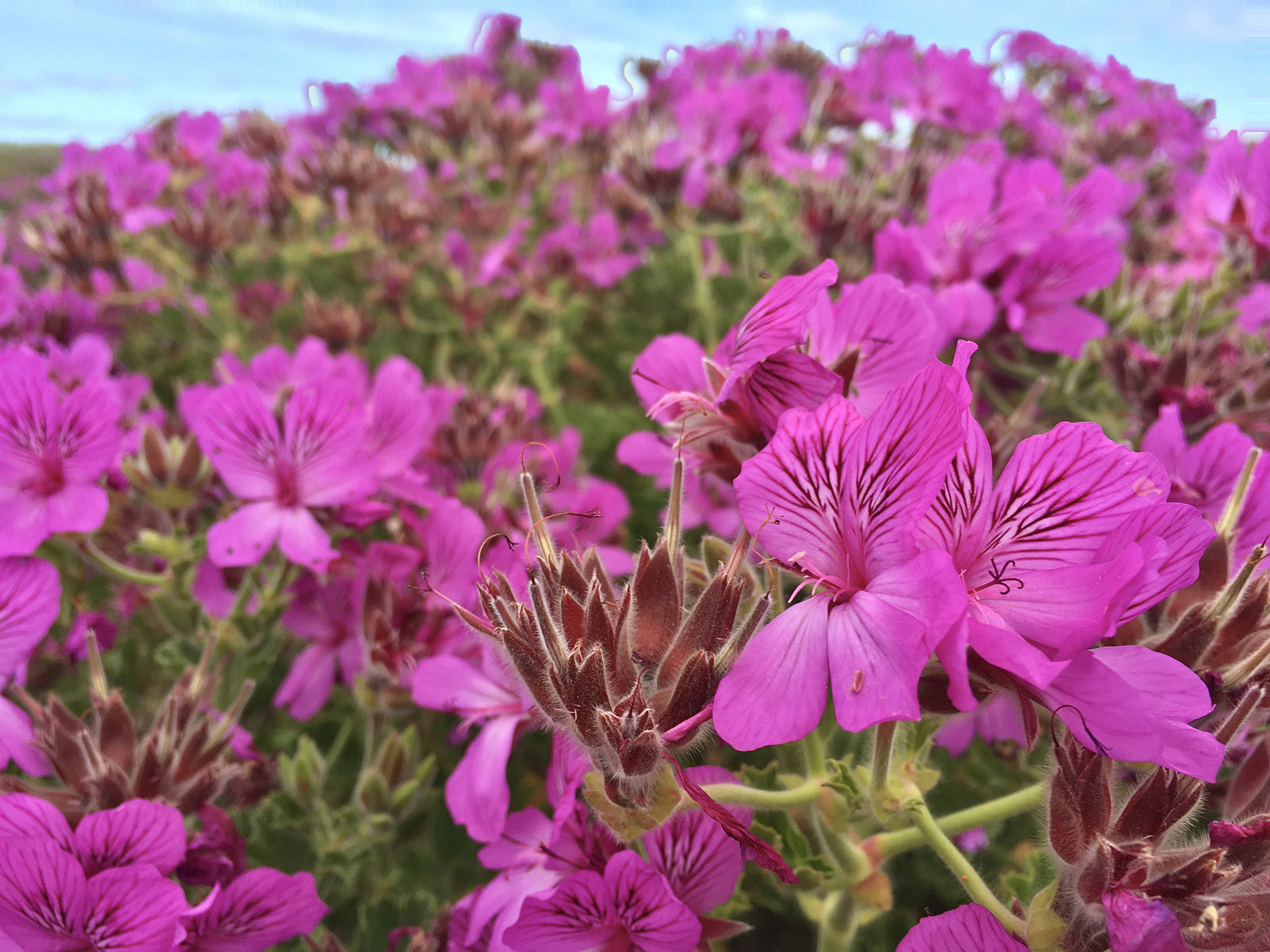
Wild Malva (Pelargonium cucullatum), a perennial fynbos shrub, flowering in November at the Cape Point section of Table Mountain National Park. (Photo: Tiara Walters)
Nearly 60% of fires are started by ‘vagrants’
Blazes of an entirely different nature, however, have dominated the local fire regime in recent years, park fire manager Philip Prins told Daily Maverick’s Our Burning Planet.
Starting campfires, except in a minimal number of designated picnic spots, is illegal. Visitors may only stay overnight in recognised facilities. Yet Prins says that, in past weeks alone, crews have responded to and extinguished illegal “vagrant-caused” fires in various parts of the park, including Tokai and Red Hill towards the centre and south; and Oudekraal and Deer Park in the park’s northern sections.
High numbers of park visitors, and potentially illegal fires, may yet prove particularly true of the 2020/21 summer period.
“It’s just unbelievable,” says Prins. Head of the park’s fire operations since the reserve was proclaimed 23 years ago, he offers institutional knowledge spanning nearly 40 years of conservation service to the Cape Peninsula. Despite the hard lockdown this year, he says he has seen “a massive increase in visitor numbers”.
Fanned by a raging southeaster, Deer Park’s “Halloween fire” on 31 October has so far proven the largest of the spring/summer blazes to be traced to illegal campfires. To contain the inferno, which singed 50 hectares 0n the mountain’s frontal slopes, it would take 16 fire trucks heaving with up to 6 000 litres of water per tank, plus crews from across the firefighting spectrum: city, park and volunteer corps.
As for the previous summer season over 2019/20, there were 108 fires in the park, according to official fire-investigation data seen by Our Burning Planet. The majority of these blazes — 58% — were associated with fires kindled for cooking, heating and socialising. In a few cases, arson looked to be the cause. Additionally, the red wedge of the pie chart attributes 32% to “malicious” origins; while 9% were sparked by “negligence”. Much of it starting over summer weekends on the front of Table Mountain as well as adjacent Lion’s Head and Signal Hill, crews contained close on 90% of fires within 90 minutes.
“A lot of vagrants come in during the night, or late in the afternoon,” explains Prins. “They move from the city into the park and, early the following morning, they move from the park back towards the city, and so it continues.”
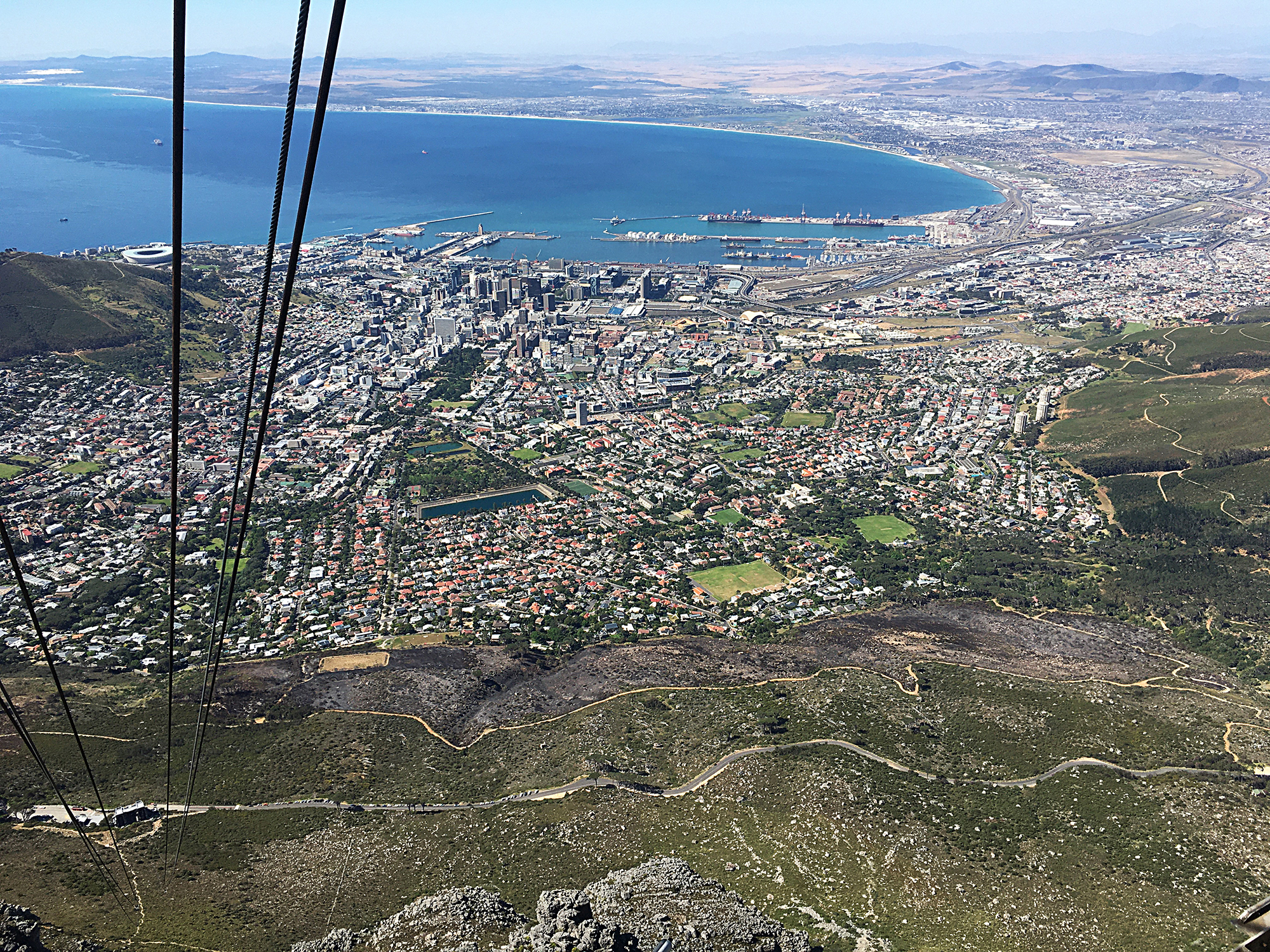
The aftermath of the Halloween fire as seen from the cable car, which burnt 50 hectares on the lower slopes of Table Mountain on 31 October. (Photo: Tiara Walters)
Thick bushes, watercourses and public drinking points on the mountain’s lower slopes tend to be a haven for illegal campers, driven into such spaces by poverty, homelessness and hunger. Shallow, overhanging caves, set a considerable distance from the urban edge, tend to attract church groups practising fire ceremonies. (Recently, the Noordhoek Ratepayers’ Association also reported that subsistence/muti poachers around the nearby wetlands use fire to flush out wildlife.)
Prins adds that “we now sit with a serious issue, not only with vagrants, but church groups, who tend to arrive on Friday or Saturday nights. One evening we put out a group of 50. Newlands Forest is especially popular. And, they divide into smaller groups, each of which has to make its own fire.”
To tease conspiracy theory from fact, and stitch together a bird’s-eye view of ignition trends, each incident is scrutinised by Enviro Wildfire Services’ Rob Erasmus, the park’s independent fire investigator.
In 2018/19, “vagrant activities” caused 32% of fires, marginally down from 2017/18’s 36%.
“We accept that the time period of three fire seasons is too short to suggest any significant trends,” Erasmus cautions. However, “to start determining patterns and trends, from 2017 we started tracking and keeping a record of all fires that we investigated within the park.”
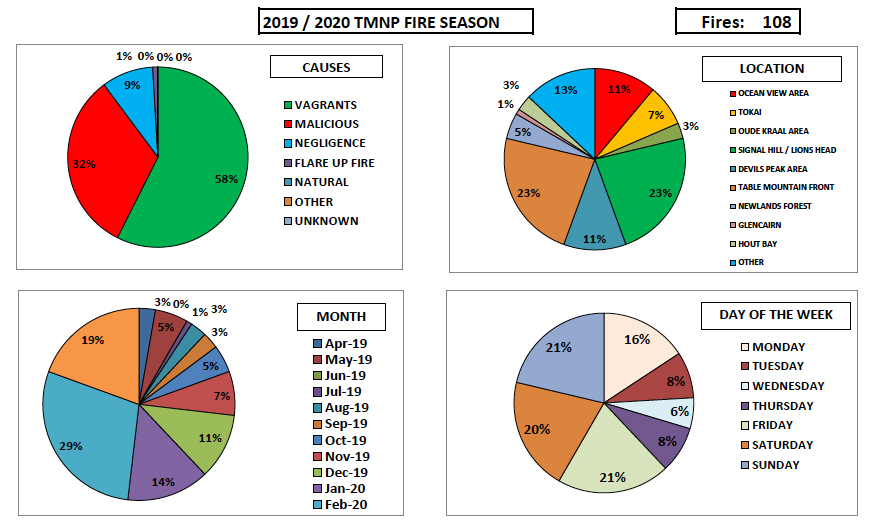
The results — including cause and location — of the official investigations into the 2019/20 fire season in Table Mountain National Park. (Source: South African National Parks)
“I think it does require looking at the data,” says Nicky Schmidt of the non-profit organisation Parkscape, which campaigns for user safety within the buffer zones that abut the urban interface. “You could have few people doing this, but repeatedly. For example, in 2018 in Tokai, we had something like 27 starts over a two or three-month period. We soon realised the starts were on weekends, in the early hours of the morning. The pattern, and evidence found, tells you what you’re dealing with.”
Dr Jasper Slingsby is not as much concerned about “vagrants” as he is about people at large: “About 99% of the fires are started by people — vagrants or not. To my memory, the 2015 Cape Point fire, ignited by lightning, was the only natural fire to have taken place in the park for some time.”
Of course, Slingsby, a fynbos/biodiversity scientist with the South African Environmental Observation Network (SAEON), is not referring to the great fire of March 2015. Igniting above Boyes Drive in Muizenberg and sweeping across the peninsula to Chapman’s Peak, it left a swath of significant damage, including destroying several properties. Here, again, the evidence tracks to an illegal campfire.
“A small fire was made to keep warm once entering into the low, thick cloud on the mountain that night,” Erasmus told Our Burning Planet. The accidental fire starter had “walked over the mountain from Muizenberg to Sun Valley … the fire either got too big or was left unattended once the person proceeded on their way.”
Home is where the hearth is
The human element aside, natural fynbos blazes should ideally ignite, on average, every 12 to 15 years as a result of dry, hot, windy conditions interacting with mature, indigenous vegetation. As Dr Alanna Rebelo of Stellenbosch University’s Department of Conservation Ecology and Entomology explains, well-timed flames are to fynbos what raindrops are to desert. “Most fynbos needs fire not only to flourish but to survive. This is because many fynbos guilds [types of plants] are dependent on fire to complete their life cycles.”
Enter the private lives of protea “babies”, stockpiled as seeds in closed cones, lying in wait for the rousing kiss of veldfire.
The fire, says Rebelo, “stimulates the cones. After the fire, the cones spring open, popping the protea seeds into the air and all over the ground. These seeds germinate, and more protea babies survive to the next generation, ready to make babies in time for the next fire.”
Some fynbos species have evolved ways to stuff their seeds in the ground, rather than in cones. “If they want to get babies from seed to adult plant, these seeds under the ground need to germinate. What germinates these seeds?” she asks. “The heat and smoke from fires.”
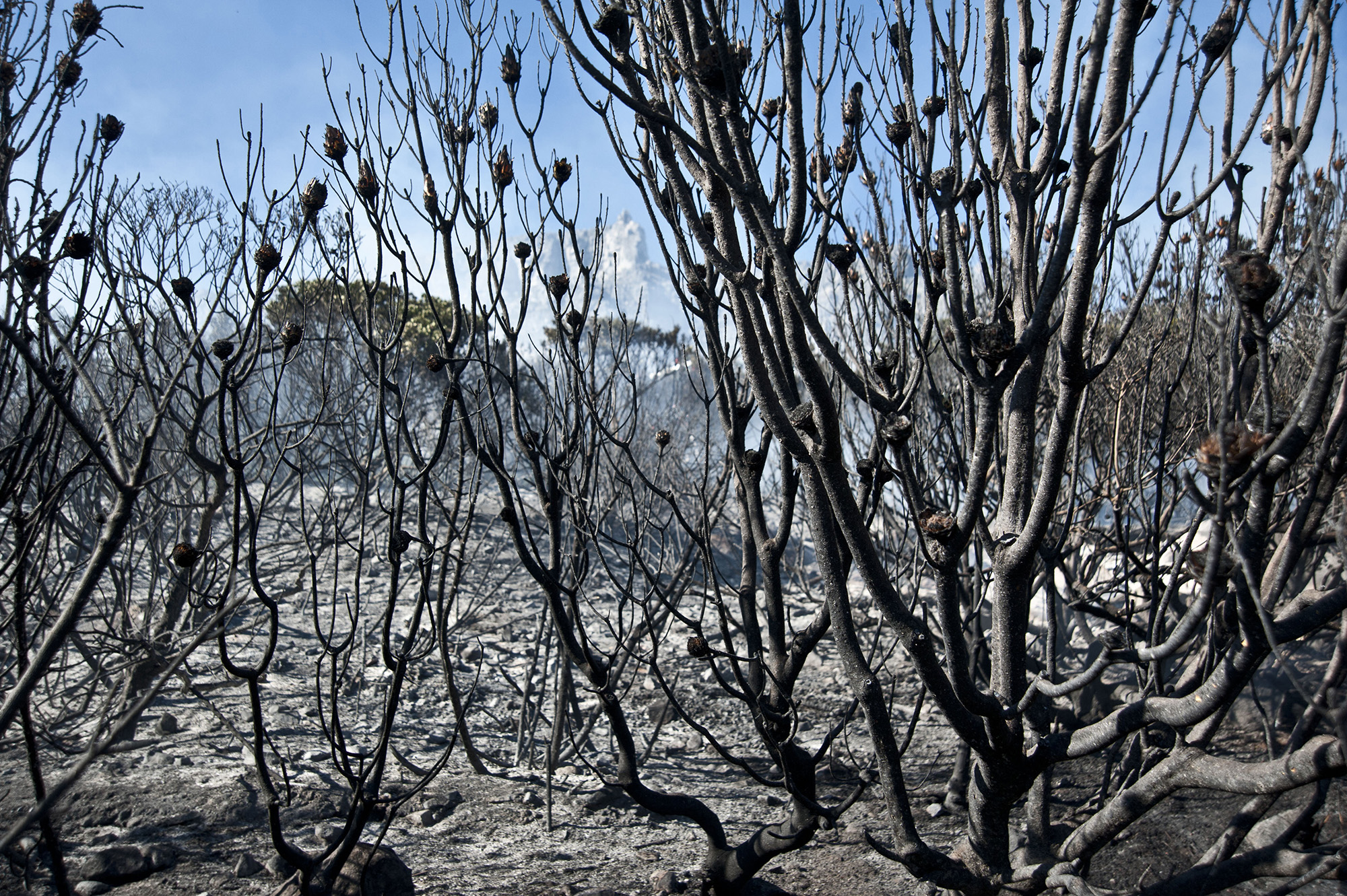
Burnt protea bushes after the Halloween fire on the frontal slopes of Table Mountain on 31 October. (Photo: Don Pinnock)
It is likely no one knew fire better than the Cape’s first people themselves.
Over time, these early agriculturalists had ample opportunity to gather mental data of the land’s bursting into abundance after good fire had rippled through it. They may have had such an implicit understanding of fire and its uses, the original theory suggests, that they would have used the practice of “fire-stick farming” to broker access to pantries of underground bulbs. This year, a South African/US study claimed to have unearthed vital clues supporting that hypothesis — the first quantified evidence of significantly amplified returns in post-fire fynbos.
Given this deep human-fire-fynbos symbiosis, it is tempting to dismiss contemporary human-caused fires from the park’s laundry list of conservation challenges — critical resources may arguably be better directed at tackling the cascading effects of climate change, poaching, litter and violent crime in a park that generated a pivotal R300-million for tourism coffers in 2018/19.
The area affected by the Halloween fire, for instance, had not received a proper burn in some 15 years, so this was one piece of land crying out for fire, Prins stresses.
Still, the science of fire ecology tells us that a “Goldilocks” confluence of conditions is necessary to maintain these natural cycles, which are delicate and may be easy to disrupt.
“It takes proteas a few years to make their cones. Fires that ignite too soon could end up killing the proteas before they have had time to set seed, leading to local extinctions,” Rebelo warns. “A fire that is too hot, due to invasive alien plants, could scorch underground seeds and kill them, as well as the organic matter in the soil, making soils hydrophobic. A fire that is too cool — in the wrong season — may not stimulate seeds at all, and only weeds may grow.”
Similarly, unseasonal fire “could also kill babies of animals that have timed their own life cycles with periods when there would be very low risk of fire”.
Slingsby, the SAEON biodiversity scientist, also notes that “increased fire frequency is the common story across fynbos because of added human ignitions. Parts of the mountain, such as the Cape Town City Bowl section, have burnt too frequently … if you consistently have hotter or more frequent fires, you’re going to see changes in the ecosystem.”
Although “very few fires are started by vagrants with malicious intent”, park fire investigator Erasmus adds that “any fire started by vagrants in young veld — five years or younger — is detrimental to the environment … In many cases this young veld consists of fine fuels — shrubs and young woody plants — that ignite and spread fire quickly.”
Last year, “a number of fires occurred in youngish veld”.
Thus, layer the ill-timed effects of bad fire on top of the rejuvenating effects of good fire and you feed too much fire into the system. And the Halloween fire’s timing, experts interviewed for this article agreed, was … well … somewhat off.
It was “very early for such a big fire” — the “official start of the Western Cape fire season is only 1 December”, says Prins.
Slingsby agrees the fire was “certainly early. Almost all fires happen in December and January. October/November fires are rare on the peninsula.”
Malicious or accidental fires, especially those that ignite out of season, may also conflict with issues such as firefighting readiness and fire management.
Cutting firebreaks, wide strips of land designed to stop fire from spreading, is an expensive, big operation: in the region of R2-million annually. This takes place once a year, and then largely within a certain time frame in November and December to avoid vegetation regrowth.
There is also the cost of the firefighter’s arsenal: the park helicopter is only on standby from 10 November each year; City helicopters are on standby from 1 December. Keeping a helicopter in the air now costs R36,000 an hour.
“We can spend up to R12-million on integrated fire management, depending on the season,” says Prins. “During a busy season, we spend more than that.”
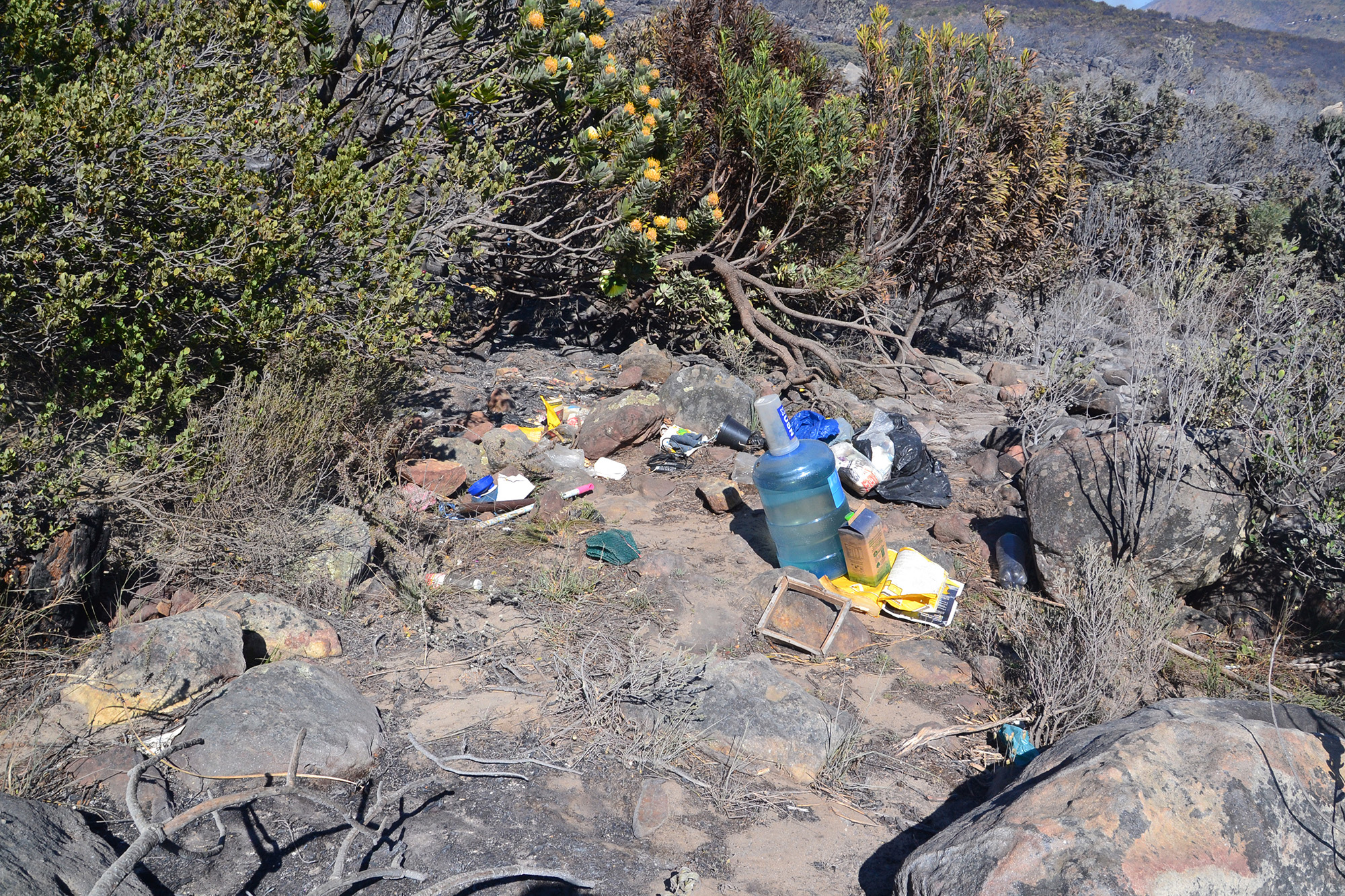
The illegal camping site where the Halloween fire originated. (Photo: Rob Erasmus / Enviro Wildfire Services)
Grace under fire: Job on the job
During Our Burning Planet’s conversation with Prins in his office at the Newlands Forest firebase, the white-haired, bearded fire veteran wields an unwavering gaze as he sets out the occupational hazards of running a portfolio that unsurprisingly generates a lot of public emotion. His daily to-do list ranges from pacifying the fire Karens on the park’s fabulously wealthy urban edge to juggling the politics of prescribed burns.
“If we do a prescribed burn, the people complain,” he says. “They complain about the smoke. They complain about the ash. After the fire, they complain about the wind blowing ash into their houses and they complain about the wind blowing ash into their swimming pools.”
The point behind these burns is to reduce fire hazards, such as alien vegetation.
“And it’s a process we have to go through in terms of applying for permits, especially on the wildland-urban interface,” he says. “I think people definitely need some more education when it comes to that. And they also must take some responsibility — they can’t expect the park and the City to do everything.”
For her part, Rebelo suggests the debate on fire ought to direct its attention at what she considers to be the “root issue” — vegetation fuel loads, rather than only the ignition source and its associated “conspiracy theories”, whether the latter may involve supposed natural causes such as lightning; or human causes such as cigarette “stompie” offenders.
“Everyone makes a huge fuss about arson, and there are all kinds of conspiracy theories every time there is a fire,” she says, referring to the 2017 Knysna megawildfires as an example. “And while that is understandable, what about the officials/landowners responsible for the vegetation itself? It’s not only about ignition, but about fuel management. This always seems to be ignored. It is so much less exciting for people.”
She recommends allowing naturally ignited fires to “burn out” at regular intervals in keeping with the natural fire regime, “or you need to actively manage vegetation using ecological burns to make sure the fuel loads don’t increase too much”.
However, “authorities often do neither”, she argues. For this, she fingers an “unfavourable policy environment” as a “dangerous, counterproductive and passive approach to fire management”. In terms of prescribed burns, “if they start a fire, they are liable. In terms of non-prescribed burns, if adequate attempts are not made to stop a fire, the landowner on whose land the fire crossed is liable.”
She says putting out every fire and doing no ecological burns “results in ageing vegetation. When it does burn, it burns very hot, and can result in megawildfires.”
“There are some 50,000 or so landowners bordering the park, and everyone has their own opinion on fire management, but not everyone is well-versed in fire ecology and fire safety. Managing fire is really more of a people problem than an ecological problem,” says Slingsby.
Given what he calls “the practical and financial constraints”, he says the park’s fire department is “doing a world-class job, for the most part. We also need to consider that the human factor has distorted fire on the peninsula to such a degree that mimicking the natural regime through fire management is a huge undertaking and can be at odds with managing fire risk. For an ecological burn, you need the hottest, driest conditions.”
But that is not what you want for fire risk, he says, because it is hot, dry conditions that set off wildfires in summer.
He acknowledges alien vegetation as both a fire and an ecological risk but deems the issue “reasonably well managed — just look at the Cape Point section as an example … bearing in mind that alien vegetation is always going to be a problem. People forget that Table Mountain was once under the cover of 75% pine trees. The problem is budgetary constraints and, when funds do become available, there are other priorities to compete with, like security.”
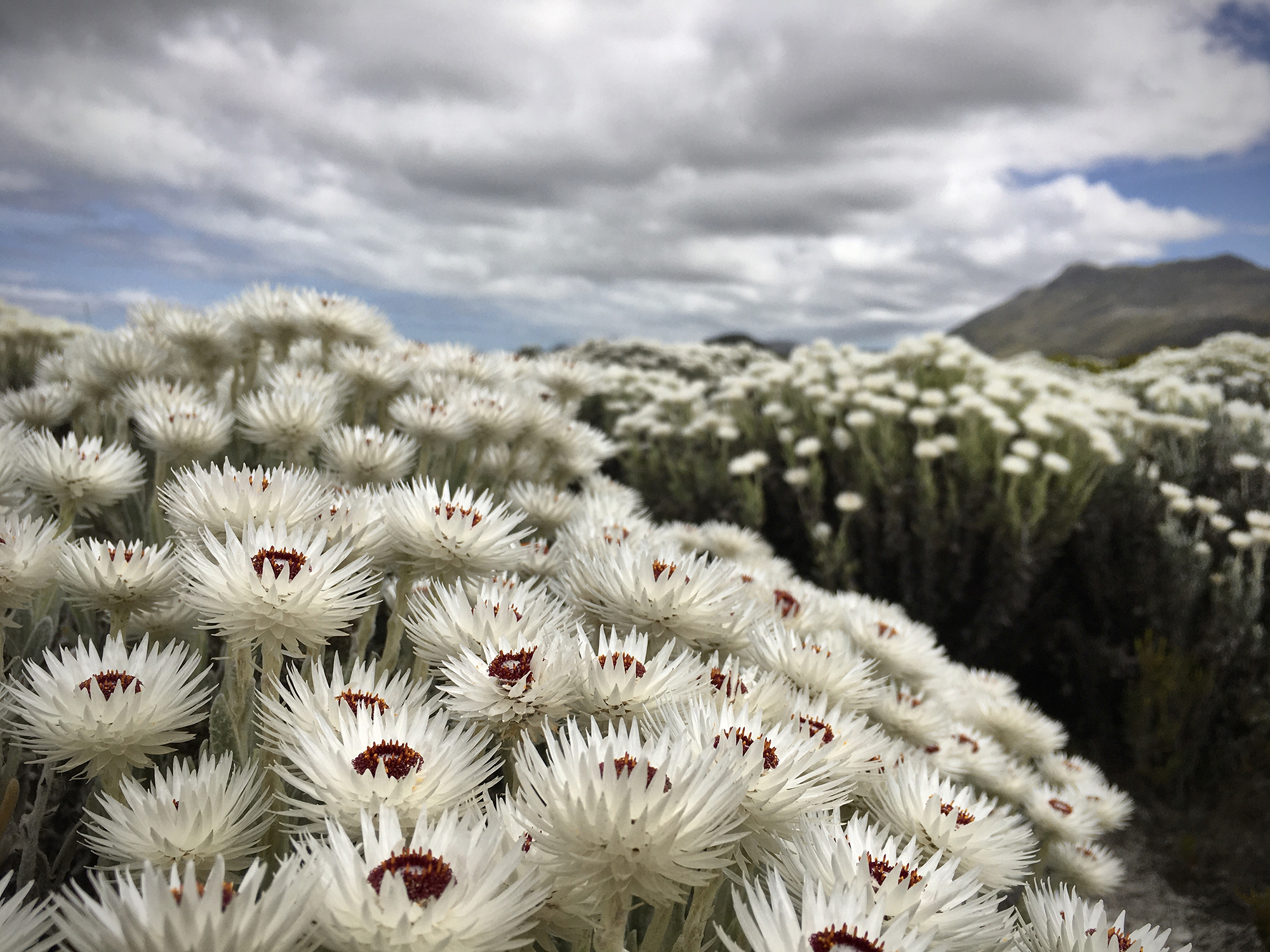
Syncarpha vestita, commonly known as Everlastings or Cape Snow, flowering in November at the Cape Point section of Table Mountain National Park. (Photo: Tiara Walters)
‘More eyes and ears’
More lateral interventions may have to address a problem that Prins, due to retire next year, says has existed in the park for decades: “We manage a park in a city. We had a problem with vagrants in 1983 and we still have a problem with vagrants.”
In interviews with park staff, City officials and non-profit campaigners, two conflicting themes dominated: the obvious, staggering complexity of the deeply systemic social dilemma driving the phenomenon of illegal campfires in particular. And the need to police hotspots with increased patrols.
Parkscape’s Schmidt stresses that resolving issues “like this” is, well, Sisyphean in scale. The cycle of visitors ebbing and flowing through the park’s porous, flammable borders from a city of about 4.6 million people, and thus policing potential fire starters, may be akin to plugging the Atlantic with a sieve.
She observes that “indigent people have lived on the mountain for many years and continue to do so. It’s a difficult and sensitive issue, as is any issue of homelessness across the city, and reflects any number of unresolved social issues and failures.”
Within the park itself, the issue “begs questions of human rights versus environmental legislation”.
The park is home to sacred sites for church groups, she argues, so there ought to be ways of accommodating such practices, such as building firebreaks around designated zones that meet ceremonial needs.
“Flora and fauna may take priority in a rural park, but it doesn’t work like that in an urban national park with a diverse population with multiple needs,” she says. “Our Constitution is anthropocentric. It’s a people-centred democracy. We need protocols for an African country.”
Focusing on hotspots, however, she suggests, “the only way to begin to manage the situation is more eyes and ears, possibly drone usage — currently forbidden, and not without issue, in national park spaces”.
Her concerns speak to the regularity of policing as much as they do to the visibility of it: “Park users regularly complain about the visible lack of rangers, but that is what is needed here to prevent crime and fires, especially in the busier buffer zones, where fires, in particular, risk causing millions of rands in damage to property, and may even take lives.”
Andy Davies of the park-users forum Friends of Table Mountain (FoTM) is keen to point out that the group is “mindful of the housing crisis in Cape Town and South Africa at large. But the bottom line is Table Mountain is a national park. It is illegal to live on the mountain and unfortunately, vagrants are associated with litter, security and fire. This is where law-enforcement is critical.”
And, yet as both interest groups emphasise, being homeless in Cape Town is hardly a crime.
Few people understand this better than Hassan Khan, CEO of Haven Night Shelter welfare organisation, established in 1978. Khan is a well-known champion for the city’s homeless and is not convinced these roaming residents need lessons on making fire.
‘It is not illegal to be homeless’
Khan describes himself as a nature lover and passionate hiker who grew up in the suburb of Salt River, and made campfires in the mountain caves of his youth. He even watched homeless people in Van Riebeeck Park on the slopes of upper Oranjezicht stoking their own cooking fires during the winter lockdown period of June, July and August.
“Those fires were made of twigs between rocks next to a river. Three or four cooking groups used small pots — five litres max per pot. It’s totally impractical to have a big fire while you’re sitting with a small pot. You’re going to burn your hands and your eyebrows, nè?” he laughs.
“It’s just plain common sense, man,” says Khan, whose organisation runs 15 shelters in the Western Cape, nine of which are in Cape Town. It is the province’s largest shelter organisation. “Stack a pot like that onto some rocks, and you’ll quickly see it burns very efficiently and it burns out completely.”
Most veldfires ignite “as campfires left to smoulder when people go into their tents, and then the wind whips it up, but the cooking I saw didn’t cause fires and it was extremely unlikely to cause fires”.
Everyone wants pristine parks but few seem willing to support the most vulnerable people who have little choice but to survive on, or beyond, those park borders, he suggests. “Environmental fundamentalism”, as he calls it, is yet to integrate into South Africa’s democratic era.
“People love the park more than they love people, and much of that comes from an apartheid idea of South African society,” he says. “Environmentalists and academics always know where you can’t build houses for black people, but they’ve never been able to identify which areas are suitable for that purpose.
“The idea that poor people by their nature will go in and destroy the park is a fallacy. We don’t support them materially. We just make political statements from time to time. But if people were to find utility in the natural environment, they would protect it. We need to create good spaces for everyone instead of building fences, and just hoping for the best that future generations will still be able to enjoy these parks.”
Khan is also not convinced that the Covid-19 pandemic has created “an absolute increase” in the city’s homeless population: “It’s the movement of the same people” who have been displaced from their normal routines, and “they’ve certainly become more visible”.
When approached for comment on how the City of Cape Town may support park patrols, City officials suggested that they were doing enough; and that, short of reintegration, there was not much more they could do.
“The only solution to the challenges presented by street people … is through reintegration of people living on the streets, and mitigating the risk factors that result in them ending up on the streets,” says councillor Zahid Badroodien, mayoral committee member for community services and health. “Despite the best intentions of the City of Cape Town’s Street People Unit, it is a reality that many people simply refuse any form of assistance. They cannot be forced to accept help either, since it is not illegal to be homeless.”
Wayne Dyason, spokesperson for City law enforcement, insists that the Law Enforcement Tourism Unit “patrols the trails on the front face of the mountain. They have acquired ebikes to assist them with their patrols. The unit has been very active in the area.”
In its emailed response to Our Burning Planet, SANParks’ head office praises the City for being “very cooperative”, while also, somewhat ambiguously, hinting at past tensions: “[We] know how the problem is pushed to-and-fro if we do not act in concert.”
The agency adds that the “clearance of vagrants is complicated and sensitive; our forthcoming interventions will be within the law … We endeavour to roll the problem back, despite serious limitations that cannot be mitigated by SANParks alone … ”
A senior agency source speaking on condition of anonymity says “tens of millions” has been slated to be poured into a new mega security centre, one overseeing a range of issues, from poaching to crime.
The agency’s response confirms a “command, control and communications centre” has been launched without fanfare. This will cooperate with “TMNP SEAPLESS: Sustainable Environmental Asset Protection, Law Enforcement, Safety and Security”. The idea is to “rapidly grow from immediate intervention demands to a predictive analysis, not a quick fix; a sustainable and reliable partner in Cape Peninsula growth, safety and security”. The new operation is “loaded with the best professionals in our area of responsibility”.
Unlike the park’s current emergency helpline, currently first routed through the City’s “107” emergency-communication centre before finally reaching SANParks officials, the new centre will supposedly handle the helpline directly, hopefully eliminating further stressful delays.
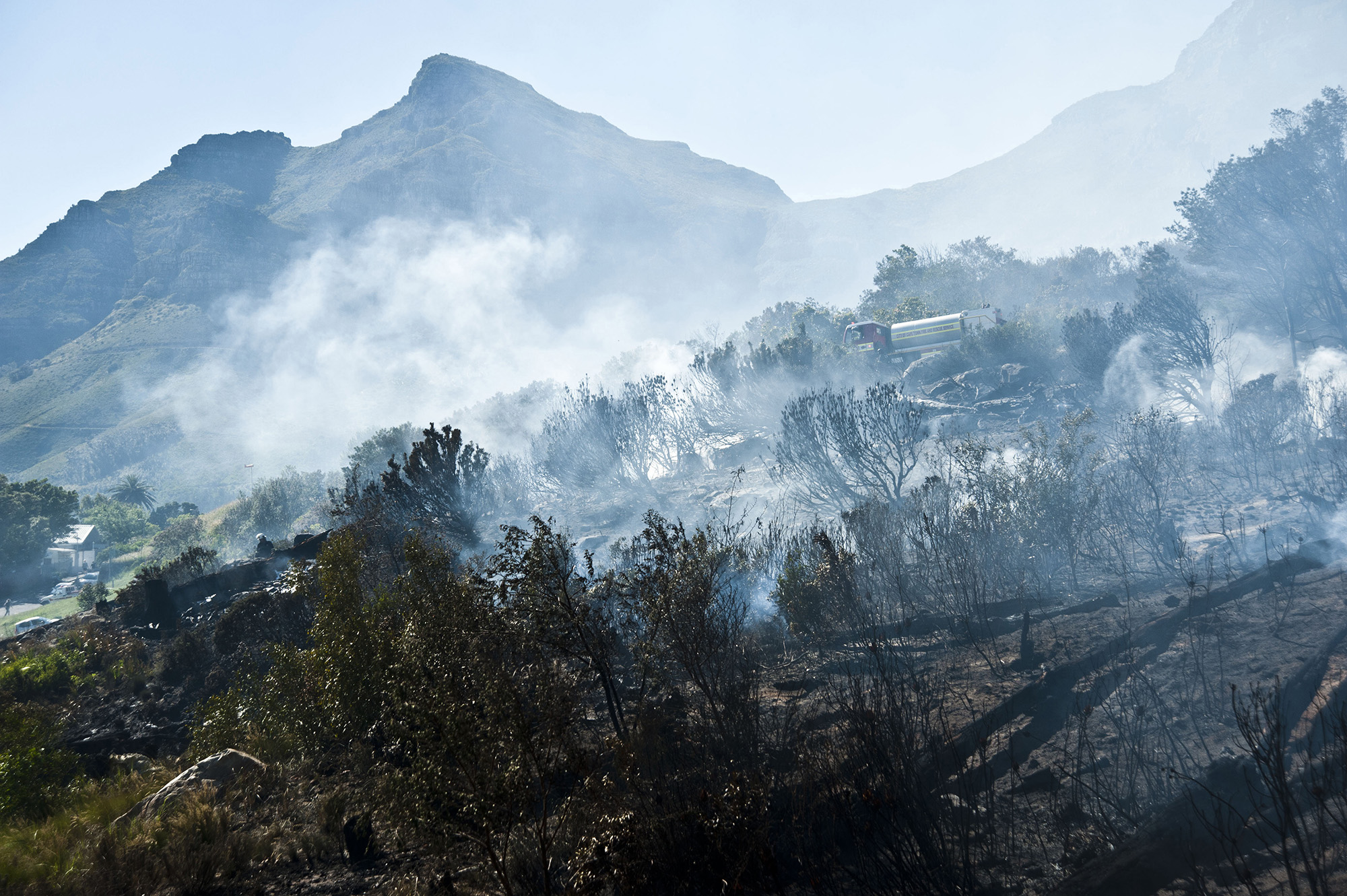
The smouldering landscape and residual fire crews after flames had torn across Table Mountain’s lower slopes on 31 October. (Photo: Don Pinnock)
Such a streamlined service would not be without merit if the experience of the person who reported the Halloween fire tells us anything. That person was Professor Wolfgang Preiser, head of Stellenbosch University’s medical virology division.
“We saw the smoke and thought how irresponsible it is to make fire in a howling wind,” Preiser wrote in a social media post shortly after the inferno. “Fire was quickly getting bigger so we called TMNP [Table Mountain National Park] offices, were cut off about 10 times, and finally told to call Newlands fire station. Then everything was very fast — when back down, fire engines all over.”
Preiser confirmed to Our Burning Planet that he had written the post “following our short hike with family and a friend from Deer Park up to Tafelberg Road and back down”. Noting the smoke in the region of Platteklip Stream flowing down from the gorge, his description echoes the findings of the park’s official investigation, which traced the ignition to Platteklip stream near Deer Park below Tafelberg Road.
“The Platteklip stream site is a favoured location for vagrants,” says Erasmus. “While it cannot be regarded as an illegal settlement — there are no informal structures and it is not used on a permanent basis — it is, however, frequently used.”
At the time of writing, the fire starter or starters were still at large, although Erasmus says “it’s not impossible to catch such a person”.
“In cases where accidental or malicious fires are set, considerable effort is required to identify such people as they are both devious and cautious,” he notes. “We have been successful on a number of occasions that have resulted in plea bargains, hence the outcomes not being publicised.”
Once upon a renosterveld
On the hot, blinding morning after Halloween, 16 fire trucks stationed at Deer Park had become one. Like the ghosts of dead plants and animals, smoke columns ascended the charred slopes. The mountain’s sandstone and granite face reared up behind the curtain of twirling wraiths.
An owner of an urban-edge mansion who preferred not to be named was philosophical about life on the fringe of this flammable mountain.
“If you want to live in a spot like this, you’ve got to take the rough with the smooth. You can’t complain because you’ve built a damn great big house where it’s not supposed to be,” he said. A thin shield of firefighters was all that had stood between his home and the fire the night before.
Still dusted with soot, he angled his shoulders to move back inside, but not before gazing out across his seared view.
“Sure, we’ve had too many fires, too often,” he said, but hesitated. “Look, I hate to blame somebody. When it’s someone throwing out a cigarette butt, that to me is inexcusable… but somebody trying to live? Everybody wants to talk and you can bet your bottom dollar there was someone trying to have a meal.”
The vegetation here would “burst back into life after the next rains”, Volunteer Wildfire Services wrote in a 2 November social media post and, on the other side of Kloof Nek Road separating Lion’s Head from the rest of the mountain, nature was already telling stories of renewal.
The March 2020 fire, still under investigation, had turned 60 hectares into a wild necropolis, the gargoyles of burnt-out cars presiding over it. But this year’s winter had proven a good, wet one for these inclines: in spring and early summer, Lion’s Head popped out carpets of Watsonias, Chincherinchees, vygies and the rest of the blooming party.
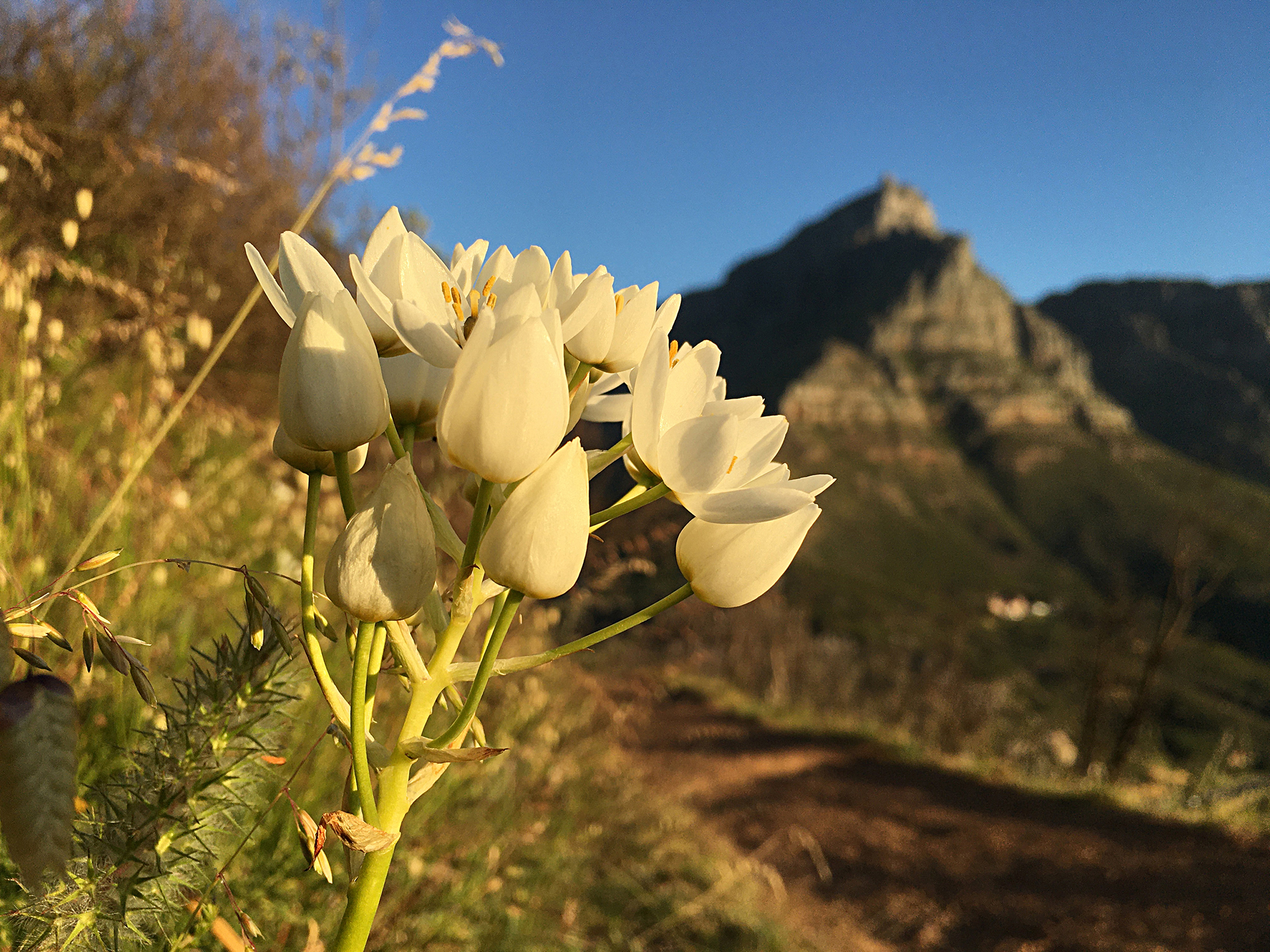
A blooming party of Chincherinchees (Ornithogalum thyrsoides Jacq.) on Lion’s Head in November, following a 60-hectare fire a few months before. (Photo: Tiara Walters)
However, two kilometres down the drag, where the Signal Hill parking area dips towards the Atlantic Seaboard’s wildland-urban interface, the slopes have burnt too often, suggests Prins. The dominant vegetation is fertile renosterveld — grasses, bulbs and daisies on nutrient-infused shale soils, rather than the typical proteas, restios and ericas of fynbos.
At least, renosterveld is what it is supposed to be. In images he is shown of the veld around the parking area, the University of Cape Town flora expert Tony Verboom also spots “weedy Eurasian annual grasses, such as Avena and Lolium; Paterson’s Curse (Echium), also from southern Europe; and Eurasian Plantago species”.
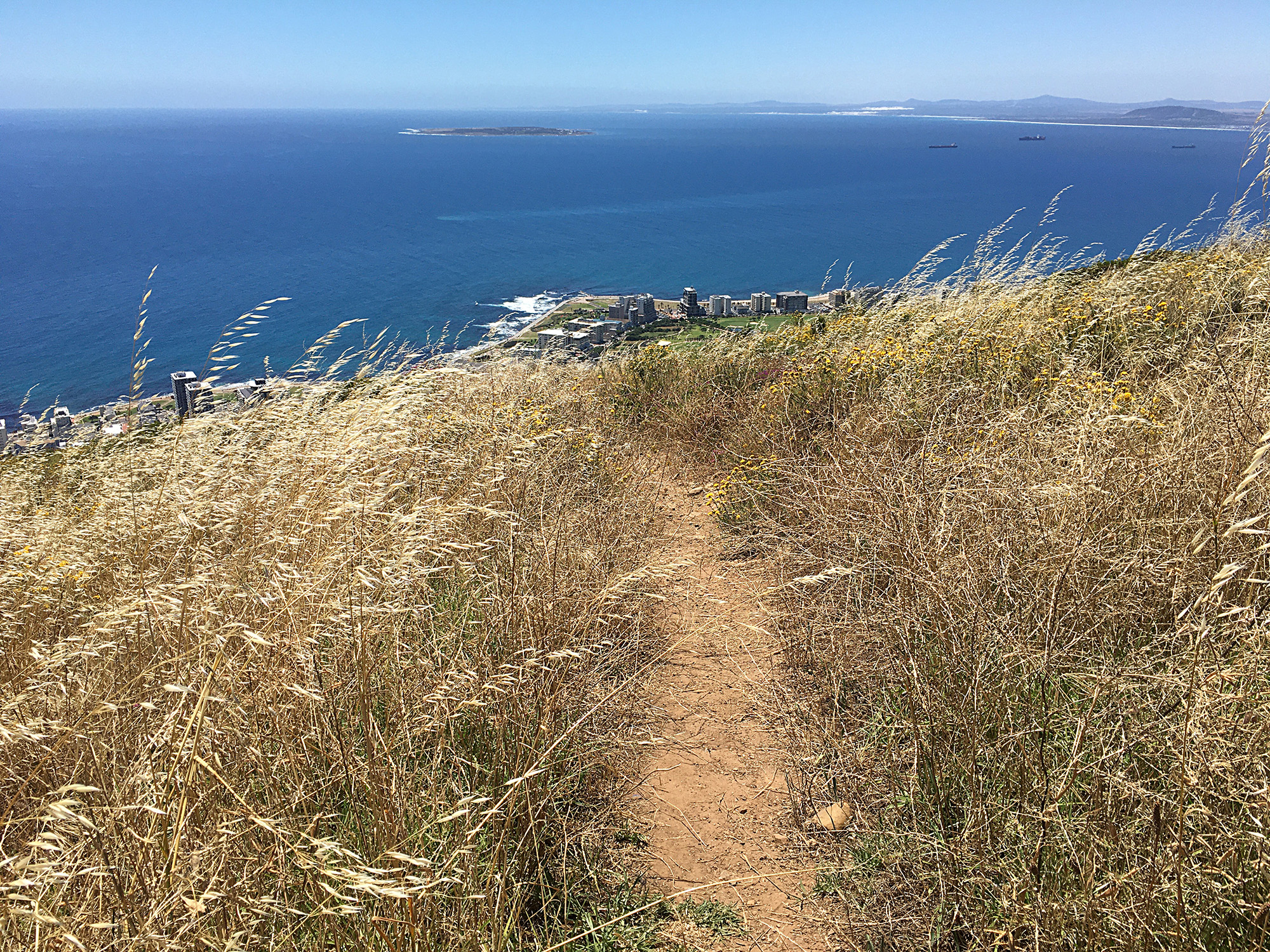
When fire and invasive alien plants meet in renosterveld, the net result is a weedy effect crowding out the local residents. (Photo: Tiara Walters)
Verboom, an associate professor, says human-caused fires exaggerate this weedy effect “by upsetting the natural competitive hierarchies and generating gaps that provide invasive weeds with an entry point”.
Impacts such as these that play out over time, Slingsby co-writes in an article on disrupted fire regimes. Initially, those shifts are barely discernible, but they tend to create slow, deep change to the very “structure, composition and function of ecosystems”.
“Kyk daar in die see — ’n belangrike man met die naam Nelson Mandela het eens op ’n tyd in daai eiland se tronk gebly,” a father pointed out to his young son in Afrikaans while Our Burning Planet was photographing the scene. [Look at the sea — once upon a time an important man by the name of Nelson Mandela lived in that island’s prison.]
Out in the bay below, Robben Island shimmered like an auburn mirage. At the father’s and son’s feet, a changing mosaic of renosterveld rippling in the wind.
“Bly mense nogsteeds in daai tronk, Pappa?” [Do people still live in that prison, Daddy?]
“Nee my kind, nou’s hy dood.” [No my child, he is dead now.]
And so it is in the 2020s that our ancestors and natural heritage are proxies for each other: without being told either existed, it becomes harder for the youngest among us to know that these people and things were once real, let alone how much they mattered to many.
It is here, across a liminal border of urban creep, that a hotter, drier climate age risks slipping into the smouldering heart of the Pyrocene Cape. DM/OBP
In the event of a veld or wildfire, click here for SANParks’ emergency guidelines.










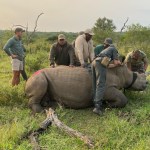








 Become an Insider
Become an Insider
Thank you for this in depth analysis. Two aspects to consider are the quality of leadership and management of the TMNP. It comes across as fragmented, reactive and uncoordinated and secondly the dysfunctional relationship with the City for which the latter has much to account and explain.
A brilliant article, thank you
Is this paragraph of the SANParks Rules and Regs not legally adequate enough to deal with the church groups, who can clap and holler from Friday to Sunday, over and above, at frequent times, during the week?:
24. BEHAVIOUR – Behaving in an offensive, improper, indecent or disorderly manner including the playing of any radio, compact disc player, music system, musical system or instrument, or in any way cause of any noise in any manner likely to disturb any species or specimen or other person is strictly prohibited and will be fined if not adhered to. The hindering, intimidating or obstructing of an authorized official in the execution if his/her duties or the performance of his/her functions will not be tolerated and is subject to a penalty. Violation, refusal or failure to obey or comply with any prohibition, request or instruction imposed by these regulations or by the management authority or authorized official will result in prosecution;
There seems to be a singular unwillingness, certainly by our local Ranger, to enforce this Rule. He says that we would need to get the noise level measured by Council and assessed to be bothersome and be prepared to go to Court. Well, it also says “any species or specimen”, as apart from “other person”, and you can be sure that birds and critters are being disturbed, and they do not have the ability to seek the Court’s intervention. Is this or is this not a Rule to be taken seriously and enforced? If not, why should any other Rule or Reg. be abided by? Either ALL are valid and enforceable, or none are? I would have thought that a noise which can be heard between 400 and 800 mts away could, quite justifiably, be considered a disturbance.